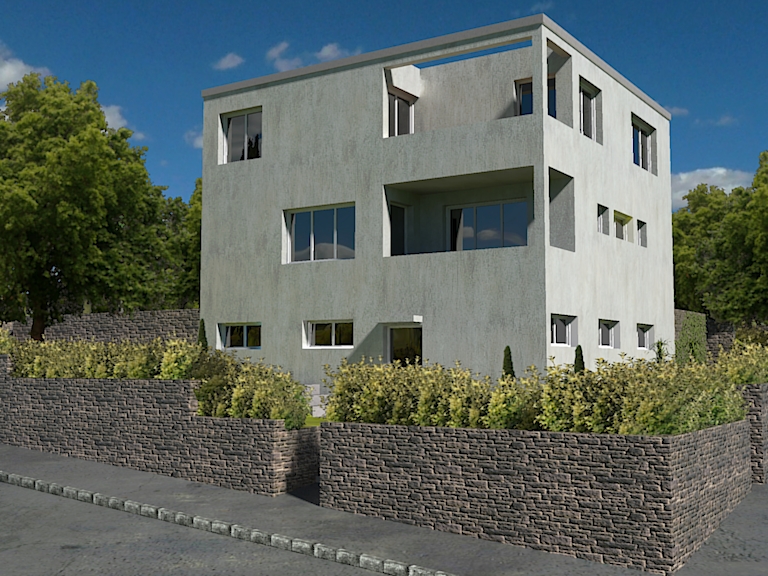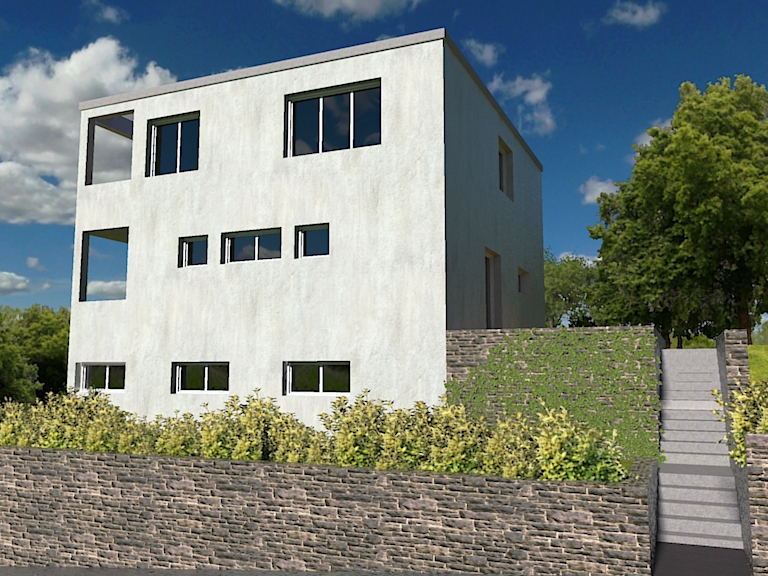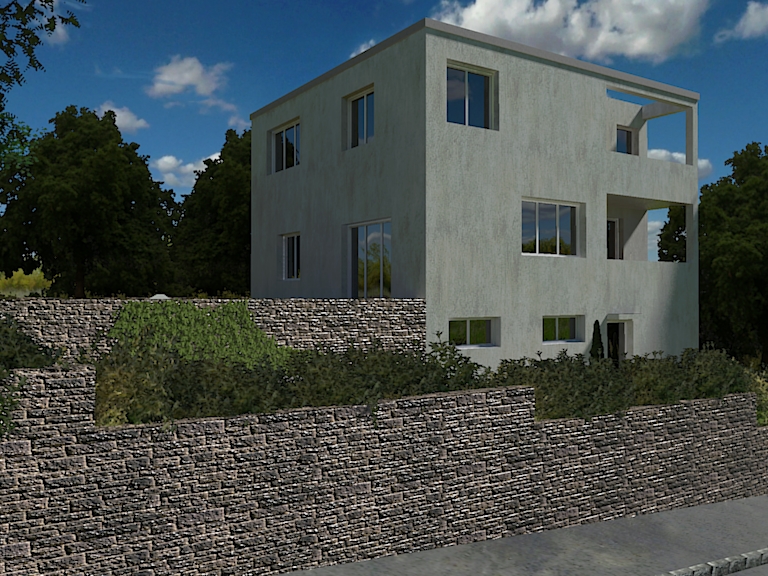Trees...a possible or not?
-
Hi CAntonis, hi folks.
Try using 2D trees or 3D trees that are ligthweigth in geometry.
Use components as much as possible to keep file size to a moderate value.
Notice that even a small file containing a very large amount of simple geometry can slow down even a fast computer because of the number of geometric items that may be displayed.
There are tricks to work with a large number of geometric items like using a style with the most basix rendering scheme, for example: no shadows, no textures, no profiles, hiding as much stuff as possible to get a working style. This style can be memorized using a scene that you can call "Work", for example.
Then create another style with all the rendering goodies turned on and memorize it with a scene called "Render" for example.
Once this is done, you can switch from one mode to the other with simply a click on the appropriate scene tab.
One more importat point, for each of these scene, disable the checkbox in front of "Camera location" to avoid loosing a carefully panned, orbited and zoomed view when switching mode.
As for components, you can also work with a temorary version of a tree component that contains the most masic geometries like a triangle and a line or an oval and a line or whatever and, when ready to complete a rendering, reload the true component to replace this temporary place holder.
You may also consider using simpler trees for those that will always be seen from a distance to minimize the amount of geometry, or even consider the use of a large flat or curved panel as a backdrop, painted with an image showing trees or even a whole forest.
Just ideas.
-
@jean lemire said:
Hi CAntonis, hi folks.
Try using 2D trees or 3D trees that are ligthweigth in geometry.
Use components as much as possible to keep file size to a moderate value.
Notice that even a small file containing a very large amount of simple geometry can slow down even a fast computer because of the number of geometric items that may be displayed.
There are tricks to work with a large number of geometric items like using a style with the most basix rendering scheme, for example: no shadows, no textures, no profiles, hiding as much stuff as possible to get a working style. This style can be memorized using a scene that you can call "Work", for example.
Then create another style with all the rendering goodies turned on and memorize it with a scene called "Render" for example.
Once this is done, you can switch from one mode to the other with simply a click on the appropriate scene tab.
One more importat point, for each of these scene, disable the checkbox in front of "Camera location" to avoid loosing a carefully panned, orbited and zoomed view when switching mode.
As for components, you can also work with a temorary version of a tree component that contains the most masic geometries like a triangle and a line or an oval and a line or whatever and, when ready to complete a rendering, reload the true component to replace this temporary place holder.
You may also consider using simpler trees for those that will always be seen from a distance to minimize the amount of geometry, or even consider the use of a large flat or curved panel as a backdrop, painted with an image showing trees or even a whole forest.
Just ideas.
Thank U very much for answering to me on such a short notice. I think I ll try the two "styles" you are refering to as I think its the most suitable solution for me, at least for now.
Its a shame, in my opinion a software like this with such good rendering engines to support it,not to be able to give the opportunity to the designers to add high res trees or vines to a project. -
Hi CAntonis, hi folks.
You can add hi-res trees and vines and whatever else to a model. The problem of slugisness (sorry if this word is not totally correct) will show when you will have too many instances of these components.
You just have to keep in mind that SU may be sluggish when trying to display millions of edges and faces. In these cases, in may be better to use a 2D component that is set to always face the camera. This component can be a single face painted with the image of a real tree. The shape shall be adjusted to fit the image as well as possible and its edges shall be hidden.
Just ideas.
-
2D trees can work pretty well most of the times.



-
@jean lemire said:
Hi CAntonis, hi folks.
You can add hi-res trees and vines and whatever else to a model. The problem of slugisness (sorry if this word is not totally correct) will show when you will have too many instances of these components.
You just have to keep in mind that SU may be sluggish when trying to display millions of edges and faces. In these cases, in may be better to use a 2D component that is set to always face the camera. This component can be a single face painted with the image of a real tree. The shape shall be adjusted to fit the image as well as possible and its edges shall be hidden.
Just ideas.
You are absolutely right. This is the best solution. 2D trees can keep the size of the project low and the SU up and running... or at least not crashing!!! LOL!!!
Thanks for the advise! -
@gaieus said:
2D trees can work pretty well most of the times.
Good morning Gaieus, good morning to you all folks,
Your trees and vegetation in your render looks very nice but my attempt had a result quite far from yours. To be more specific, I created this foto of a tree with a transparent background (Photoshop) to use as tree for exterior renderings but 2 things goes wrong,first VRay wont render the transparency (Twilight did in my test) so the result comes as it is with a white background and second, altough I import it as an image it wont manipulate it as component/group. If it isn't to much for me asking would you share some tips/tricks?
Thank U in advance,
Antonis -
Indeed V-ray cannot handle alpha transparency (yet). The solution is to add a so called "clipmap" where anything that should be transparent is black and the opaque parts are white. This will tell V-ray what to render and what not.
For further advice on V-ray, please, visit our V-ray Subforum under the Extensions... forum. I do not use V-ray myself but you can find excellent resources there.
After importing it as an image, place, align and scale it to your needs.
Now right click > Explode and SU will create a true SU face (with bounding edges) that you can aready manipulate, make a component that faces your camera etc.You could use the image entity for this, too, but some rendering engines have problems with image entities (Twilight will render them but antialiasing will take forever for instance).
-
@gaieus said:
Indeed V-ray cannot handle alpha transparency (yet). The solution is to add a so called "clipmap" where anything that should be transparent is black and the opaque parts are white. This will tell V-ray what to render and what not.
For further advice on V-ray, please, visit our V-ray Subforum under the Extensions... forum. I do not use V-ray myself but you can find excellent resources there.
After importing it as an image, place, align and scale it to your needs.
Now right click > Explode and SU will create a true SU face (with bounding edges) that you can aready manipulate, make a component that faces your camera etc.You could use the image entity for this, too, but some rendering engines have problems with image entities (Twilight will render them but antialiasing will take forever for instance).
Finally some sense!!!LOL!!!
I can't thank U enough! -
@cantonis said:
I would really like to know if there is any way to add trees to projects by designing trees or even import from photoshop without having to put up with a 15-20 MB file.
You have identified a serious problem. Keep your trees in a separate layer. A truly huge tree layer will not slow SketchUp down if the layer isn't visible.
-
@martinrinehart said:
@cantonis said:
I would really like to know if there is any way to add trees to projects by designing trees or even import from photoshop without having to put up with a 15-20 MB file.
You have identified a serious problem. Keep your trees in a separate layer. A truly huge tree layer will not slow SketchUp down if the layer isn't visible.
Good evening Martin,
To tell the truth, in the last few days I tried that same thing that you suggested and it worked! That simple! I only make the layer visible when its time to render and voila! Victorius! Not exactly what I had in mind but it will do!
Thank U very much for your help!
Advertisement







